

5 Reasons Chromebooks Make Sense for Schools. Ravenscroft had been mulling a one-to-one initiative for more than a decade.
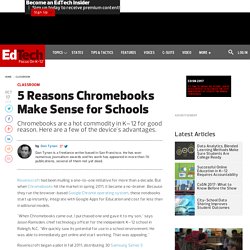
But when Chromebooks hit the market in spring 2011, it became a no-brainer. Because they run the browser-based Google Chrome operating system, these notebooks start up instantly, integrate with Google Apps for Education and cost far less than traditional models. "When Chromebooks came out, I purchased one and gave it to my son," says Jason Ramsden, chief technology officer for the independent K–12 school in Raleigh, N.C.
"We quickly saw its potential for use in a school environment. He was able to immediately get online and start working. Ravenscroft began a pilot in fall 2011, distributing 30 Samsung Series 5 Chromebooks to the 10th-grade English composition classes. "It's really made life easier for the teachers," Ramsden says. Here are five key reasons schools nationwide are dropping traditional notebooks and going Chrome. What To Know About Google Play For Education. Yesterday at Google I/O (the company’s annual developer conference), Google released a major new education program called Google Play for Education that organizes and manages the way teachers share apps, books, and other learning content with their classes.
The new store is scheduled to launch this fall and it aims to simplify content searching for schools, and to give teachers and students access to the same tools that are now native to the Google Play experience. While much of the technology news that is presented at these large companies’ conferences may seem unimportant until the products are actually released – and in many cases, completely irrelevant to classrooms – this is one of the most education-relevant announcements that has been made in recent memory. It also marks the first big push into the tablet classroom by a company that is not Apple. Google App Store For Educators Easy Classroom Content Sharing. 3 Reasons To Try Google Chromebooks In The Classroom. Google’s Samsung Chromebook is still relatively new to the tech scene, but it’s made quite a splash since its launch in October 2012.

Aptly billed “a laptop for everyone,” its $249 price tag and straightforward interface makes it a device worth considering for both students and teachers. Between the wild news that Malaysia is adopting 10 million and the new Google Play Store for Education , there’s a few reasons try Google Chromebooks in the classroom. Quick Setup. Home - Monty Melon. Chromebooks.
How to BYOT for Learning? I have been out visiting a lot of schools over the past few months learning about culture, demographics, economic status of neighbourhoods, existing and historical use of and interest in technology, and capacity to weave technology into common practice.

My District has a fascinating array of schools. I was in a 105 year old secondary school last week in a highly urban area with a rather low socio economic status. The school is quite oddly designed and has an institutional feel and look, but I suppose 100 years ago architects and District officials thought differently about school. Teaching with GoogleDocs. Stephanie Hedge is a graduate student in the Department of English at Ball State University.
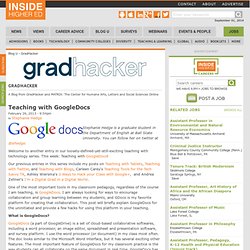
You can follow her on twitter at @slhedge. Welcome to another entry in our loosely-defined-yet-still-exciting teaching with technology series. This week: Teaching with GoogleDocs! Google Chromebooks Rain on School Children, Invade HP. The HP Pavilion Chromebook, the first HP machine based on Google’s new-age Chrome OS.

BYOD on campus - Free resource library - dave.cookson - NTLP Mail. Five steps to a sustainable 1-1 student device roll-out. The use of technology in education has evolved rapidly in the last decade, with schools, colleges and universities striving to create high-quality learning experiences through its effective application.
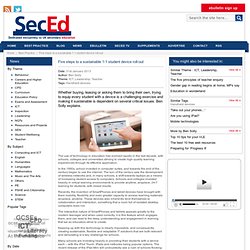
In the 1990s, school invested in computer suites, and towards the end of the century began to use the internet. The turn of the century saw the development of wireless networks and, in many schools, a shift towards laptops as a means of increasing student access to computers. Schools and colleges invested heavily in virtual learning environments to provide anytime, anyplace, 24-7 learning for students, with mixed results. Recently, the invention of SmartPhones and tablet devices have brought with them mobility, flexibility and even greater capacity to access learning materials anyplace, anytime. These devices also inherently lend themselves to collaboration and interaction, something that a room full of isolated desktop computers does not.
Educational rationale Network capacity. BYOD Case Study: Tideway School. Tideway School is situated in the town of Newhaven in East Sussex, England.
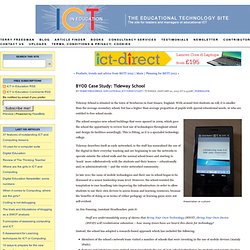
iPad or Chromebook: 4 Questions To Ask Before Choosing. Crude mashup for your enjoyment. For the past few days, I’ve been playing with a Chromebook. Though I have been an advocate of Google’s myriad web products since the beta-test Gmail account that I was invited to open over 10 years ago, I had not previously put my hands on one of these devices. I may be in love. This may come as a shock since I have spent the past two years completely immersed in iPads. I love my iPad too, and my iPhone, and my mostly retired iPod Touch. With schools and districts across the country, there seems to be this preconception that a single relationship exists with regard to technology, and in particular, with regard to making a decision about mobile devices. Small School Big Tech: The 1:1 Challenge. How To Make Your Google Chromebook Even More Powerful. Google Chromebooks are quickly becoming one of the go-to resources for cash-strapped school districts, innovative teachers, and students who need something a bit more than an iPad.
They’re cheap, fast, leverage the cloud, and are starting to make big waves in the world of edtech. In fact, you may soon start seeing more people recommending Chromebooks over iPads as they become even more powerful and more apps / tools are built for them. But that’s the problem. You need to use a lot of custom-built apps and web services to effectively use Google Chromebooks in your classroom. Like Apple’s ‘walled garden’ of apps and tools, Chromebooks don’t natively support many tools that you’d come to expect. I used a Samsung Chromebook for two weeks.
Implementing 1:1 with Android devices (Part 1 – Planning) In August 2012 we rolled out the first phase of our 1:1 program at Forrester High School in Edinburgh.
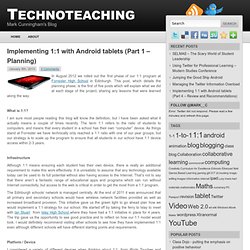
This post, which details the planning phase, is the first of five posts which will explain what we did at each stage of the project, sharing any lessons that were learned along the way. What is 1:1? I am sure most people reading this blog will know the definition, but I have been asked what it actually means a couple of times recently. Essa Academy: Bookless school where everyone has iPad. Going 1:1? How Would You Respond To Comments Like This? I had the opportunity to appear on National Public Radio’s Here and Now Program last week along with one of our students to talk about our 1:1 iPad program here in Burlington at our high school.
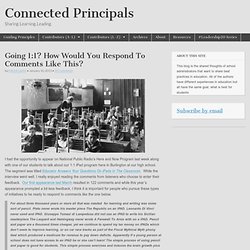
The segment was titled Educator Answers Your Questions On iPads In The Classroom. 5 Things To Know Before Deploying Education Technology. As technology advances, schools are becoming a playground for electronic devices. The use of tablets, smartphones, iPads, laptops, Kindles, Nooks, gaming laptops and everything in between has become a part of the educational world. Many schools provide these devices to students and many other schools are allowing students to use their personal devices for academic purposes.
Incorporating these devices into classroom learning takes a large amount of preparation. The school must do some preparation work to ensure Internet access, technical support, IT support and Internet safety. As these devices become a popular educational tool make sure your school is prepared to handle it. Increased Bandwidth Just a few years ago, wireless connection was mostly used for teachers who had laptop computers. BYOD Case Study: George Spencer Academy. George Spencer Academy is a mixed secondary school in Nottingham, England, with 1350 students aged 11-18.
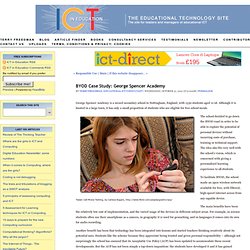
Although it is located in a large town, it has only a small proportion of students who are eligible for free school meals. Tween Cell Phone Texting, by Carissa Rogers, school decided to go down the BYOD road in order to be able to explore the potential of personal devices without incurring costs of purchase, training or technical support. The idea also fits very well with the school’s vision, which is concerned with giving a personalised learning experience to all students. To facilitate BYOD, the school made an open wireless network available for free, with filtered, high-speed internet access from any capable device. The main benefits have been the relatively low cost of implementation, and the varied usage of the devices in different subject areas.
iPads, tablets and learning. 1:1 Learning: Myth 3 – 1:1 Computing Improves Standards [complete nonsense!] Samsung Chromebook review (late 2012) Whenever we review Chromebooks, we always come to more or less the same conclusion: it's a neat idea, a computer where everything is done online, but it's not worth the money. That was back when Chrome OS devices were priced at $500, competing with netbooks that could run not just the Chrome browser, but all manner of Windows apps.
Ditto for tablets, which can be tricked out with many thousands of apps on both iOS and Android. BYOD Case Study: Sheffield High School. Blog Archive » Thinking of tablets in school. Are iPads the only solution? Why not Android? Find out why not. The new Chromebook v. The iPad. School that spent £500,000 giving its pupils iPads admits that HALF are now broken. Chromebooks – there’s really nothing to say. Refresh: The Platform.
Recently, I started looking into our upcoming device refresh. Combine Our Devices: Reshaping BYOD. 5 Reasons The iPad Will Stay The King of the Classroom. 1 to 1 computing. Apps for Education. Google Chromebook for Education Summit July 2nd 2012 – Review. Welcome to Google's first UK 'server-free school' Chrome Devices for Education Technical Planning Guide - Chrome Devices for Business Help. Education Chromebook Review Update. Google Chromebooks in UK Schools. iPad Launch to all staff- INSET: How it worked (Resources Included) « The Future of Education: Tablets vs. Textbooks. The Proposed Scheme. IT Provision in Secondary Schools in 2011 – The Masterplan.
Www.wallacehigh.org/wp-content/uploads/2009/12/One-to-One-Policy.pdf. Education Endowment Foundation (EEF)